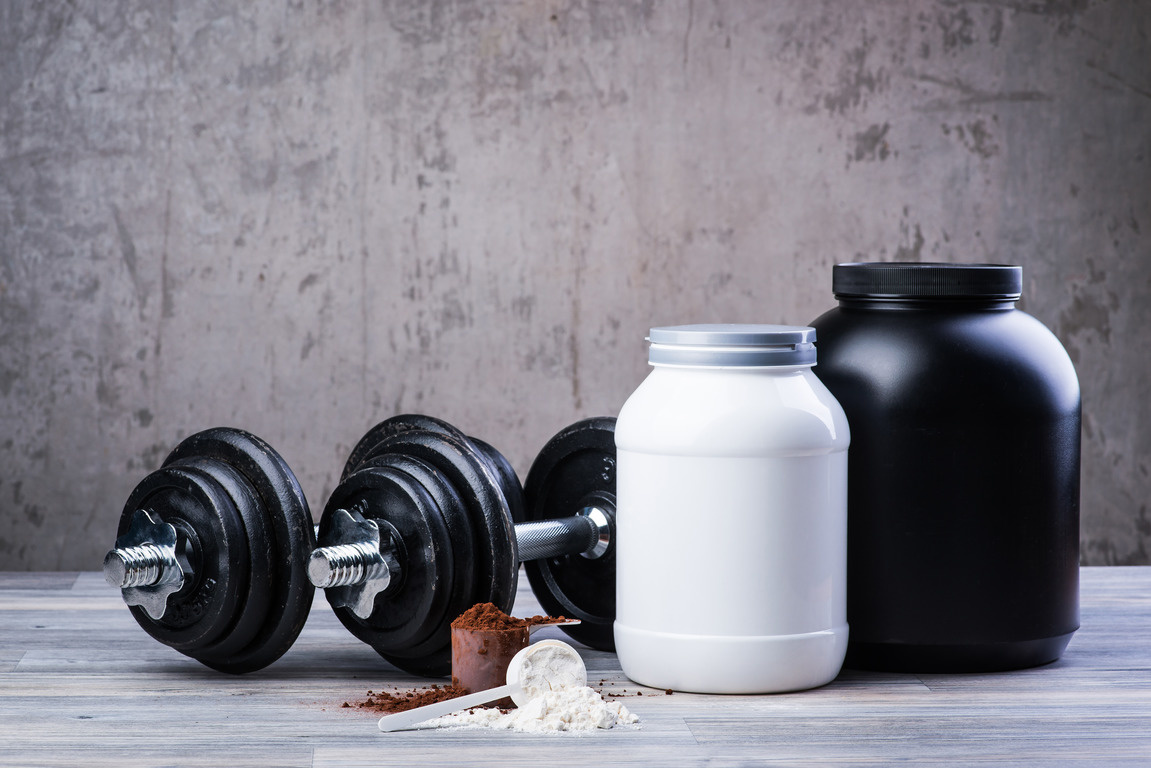
Complex basic exercises should form the basis of effective strength training. Such exercises belong in your training plan, no matter what goal you are pursuing. Especially if you want to build muscle mass effectively, you cannot avoid these exercises.
But why is that so? What kind of basic exercises are there and what makes them so special? And are these complex basic exercises really better than other types of exercise, such as isolation exercises ?
In this article I want to answer these and other questions about the effective use of basic exercises in your strength training. Among other things, you will learn:
If you are particularly interested in a topic, you can go straight to the relevant section with one click. However, I recommend that you take the five minutes and read the entire article.
What are basic exercises?
As the name suggests, the basic exercises are the basis for effective strength training. It is probably also because these exercises have a very original character. They are the reason, a good foundation on which you can build your training.
Complex basic exercises always extend over several joints and use different muscle groups. We also speak of kinetic chains or muscle chains that have to interact. They are usually done with free weights or with your own body weight.
With exercises like this, large parts of the body are trained at the same time. This makes it possible to train the most important muscles at once with just a few exercises. This enables you to lay a good foundation for your training with just a few exercises.
Of course, this also makes basic exercises very strenuous and demanding. For this reason, many avoid doing many of them in a row. However, exactly this has some advantages that you should not be without. I want to go into these in a moment.
Why complex basic exercises belong in your training plan
Basic exercises form a good basis for an effective training plan. There are actually some good reasons for this as these exercises have many benefits. I would like to briefly introduce the most important from my point of view:
Training the entire system instead of its individual parts
Due to the involvement of many different body structures, complex basic exercises are particularly beneficial for the blood circulation and oxygen as well as the supply of nutrients to these body structures. The entire cardiovascular system is also significantly more challenged and therefore trained effectively than is the case with isolated exercises. These are decisive arguments from the point of view of both performance and health-oriented fitness training.
Maximum transfer potential
In general, basic exercises also contribute to better athleticism due to their complex movement structure. The inter-muscular coordination (interaction of different muscles) is particularly promoted by the complex movement sequences. You train the individual parts of your body to work together and to act as a whole.
As a result, they are also superior to isolated strength exercises in terms of their functionality and thus their suitability for everyday use. This also leads to good transferability to other sports. Anyone who does strength training in addition to another sport should therefore rely on complex basic exercises.
More growth hormones, faster progress
When it comes to muscle growth and increasing strength performance, complex basic exercises also have a decisive advantage: due to the greater stress, growth hormones are released in significantly larger quantities than with other exercises. These growth hormones not only have a local effect, but also affect the whole body. In principle, you can only put together a very effective training plan for your strength training from basic exercises.
Less time spent on your training
A lot of time can be saved with basic exercises and I know that many people have a hard time finding enough time for training . Fortunately, complex basic exercises are extremely time-efficient. With just a few exercises, you can train a large part of your muscles and trigger growth impulses. Especially if you want to train all your muscles in a full body workout in one day, you should base your training plan on basic exercises. It would take a long time to effectively train the whole body without basic exercises.
Perfect for building up and dieting
By the way, basic exercises are not only extremely suitable for your muscle building in the mass phase . You can and should use them sensibly in a diet. The strong growth impulses promote muscle maintenance in the diet and the calorie consumption is particularly high with these exercises. When a lot of muscles are used, a lot of calories are of course burned.
In my opinion, these are the most important advantages of basic exercises. I hope that I was able to convince you that complex basic exercises should also be a central part of your training plan. The only question now is which exercises are best suited for this.
Which basic exercises are there? My top basic exercises
In principle, there are many basic exercises that follow the definition described above. In my opinion, some of them make more sense, others less. In the following I would like to introduce you to my personal top basic exercises. All but one are based on classic barbell training.
These are the six most important basic exercises that, in my opinion, should not be missing in any training plan:
The following brief descriptions also contain a few tips for correct execution, but are not intended as detailed exercise instructions. I have linked a longer article to the exercise. If you are unsure, it is best to find a good (!) Trainer who can look at your execution and give you feedback.
A damn good book that explains the most important barbell exercises in detail is Starting Strength: Introduction to barbell training by Mark Rippetoe *. I can only recommend reading this to anyone who seriously wants to do weight training.
Basic exercise 1: the squats
The squat is the classic leg exercise. Hardly any training plan comes without a variant of this exercise. There is a good reason for that, after all, all relevant muscle groups of the legs and core are used in the squats.

Very important: the knees point in the same direction as your feet during the entire movement and the heels remain on the floor as glued.
I recommend the classic high bar squat to everyone (at least for beginners). In this variant, the bar is placed on the upper trapezius muscle (above the shoulders).
For more information about the sense and the correct execution I have in the article Do the squat correctly written.
Basic exercise 2: The deadlift
The deadlift is probably the best exercise for your lower back. The deadlift also activates all of the leg muscles. With a clean execution, the entire movement via the core muscles is under tension and keeps the back straight.
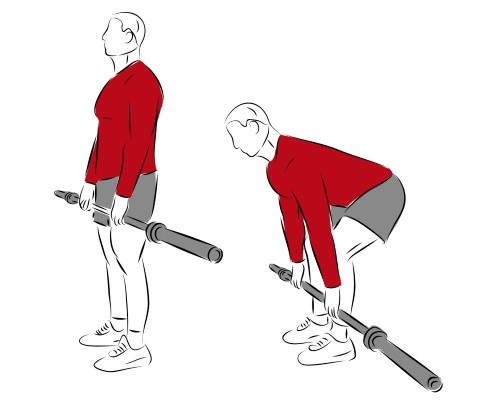
With the deadlift, however, you can do a few things wrong, which is why I can only recommend everyone to practice the exercise with little weight until they have mastered a proper process. Then the weight should only be increased so much that the sequence of movements is still clean. It is best to have your training partner check this regularly.
By the way, deadlift means deadlift in English. This is because a weight is being lifted out of rigidity. When done correctly, the weight is therefore always briefly deposited. When lifting, the trunk should then be under maximum tension again. You should definitely not work with momentum!
For more information about the sense and the correct execution, I have written an extra article about the most important rules of a good deadlift technique .
Basic exercise 3: The bench press
The bench press is probably the most popular strength exercise in the gym. No wonder, after all, the entire front of the upper body is effectively trained here. If you want strong chest muscles, shoulders and strong triceps, this exercise is definitely in your plan.
In addition, without regular bench press you would not have an adequate answer to the frequent question among athletic men “What do you do?” 😉
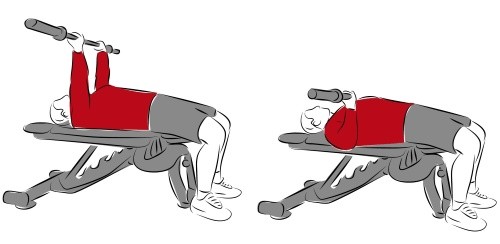
At the same time, most of the wrong things are done in this exercise, which can lead to discomfort, especially in the shoulder and elbow area. If you want to really bench press there are a few rules to follow. The most important in my opinion are the following:
- Always put your feet down
- Keep your bum on the bench for the entire movement
- Pull the shoulder blades together and fix them on the bench
- Do not reach too far (approx. 40-60 ° arms to upper body)
- Forearms the entire movement at right angles to the bar and the floor
Basic exercise 4: the pull-ups
With the pull-ups, a bodyweight exercise also made it onto the list. These exercises, or training with your own body weight , should not be underestimated. For this reason there is a separate article on the blog about the basic exercises in bodyweight training .
The classic back exercise is ALWAYS a part of my training plan. For the latissimus dorsi, the large back muscle, there is hardly a better and at the same time functional exercise. Even if I usually prefer exercises with weights because of the easier ways to increase, I do not do without this exercise.
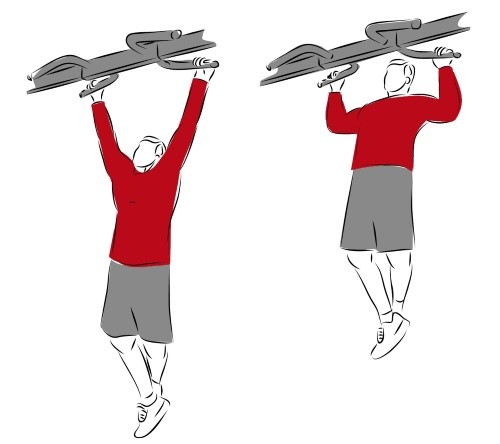
There are different pull-up variants. All have a different focus. The best way to hit the latissimus is to do a classic pull-up with an instep grip that is a little more than shoulder-width apart (palm facing forward). When pulling up, you lift your chest to the bar.
Basic exercise 5: Rowing
If you want a barbell exercise with which you can effectively train the entire back area, then there is no way to do the classic barbell row over. If I had to choose an exercise for a healthy back, I’d choose a barbell row.
This exercise is particularly recommended for people who work a lot on a computer while sitting. The posture and movement in barbell rowing effectively counteract the bad posture that is usually assumed when working on the PC. This prevents postural damage caused by PC work and at the same time improves posture when working on the computer and posture in general.
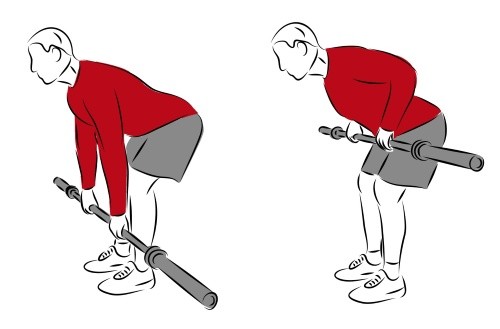
It is best if you grip the barbell about shoulder-width apart, place your feet a little over hip-width and tilt your upper body forward about 45 degrees with your legs slightly bent. The lower back is under tension throughout the movement. From this position you pull the weight along your thighs, your elbows along your body, towards your stomach. When lifting the weight off the floor, be sure to make a clean deadlift movement.
Basic exercise 6: The shoulder press
The shoulder press has been overshadowed by the bench press in recent years. The exercise is actually a bit more complex and functional. This is probably mainly because the bench press allows you to move more weight. In addition, strong chest muscles are currently a priority for many strength athletes. Nevertheless, the shoulder press should also be part of your upper body workout.
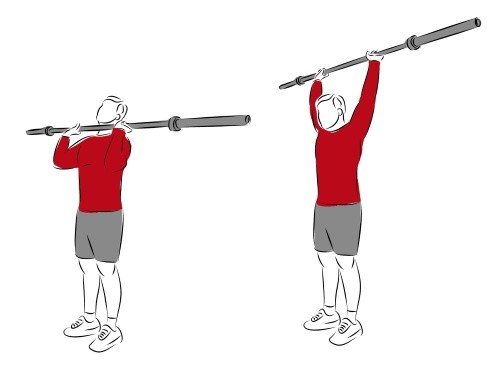
With the right shoulder press technique In principle, the entire muscle chain from the feet to the hands is involved. However, many longtime strength and bodybuilding athletes have problems with their shoulders at some point due to poor execution. Therefore, make sure that your forearms are vertical under the bar or that your elbow is minimally in front of the bar but never behind it and that the dumbbell moves up and down in a vertical line. In order for this to work, your head has to avoid the barbell a bit on its way.
The classic basic exercises also very often include the lunges . Various other exercises that follow the definition can also be referred to as basic exercises. For example, I still consider lunges to be an interesting basic exercise, as they have a high level of functionality.
How often should you do basic exercises in your training?
In short, I am convinced that you should do complex basic exercises in each of your workouts. Even if they are strenuous, they simply bring so many advantages that you should not be without.
It can make perfect sense to combine them with isolation exercises in a split training . In principle, I would always base a good training plan on such complex basic exercises as those presented above. It does not matter whether it is a muscle building training plan , a diet training plan or a plan to increase performance in weight training or to transfer to another sport.
It makes sense to start training each large muscle group with a complex basic exercise and then, if necessary, to specifically exhaust the respective muscle with isolation exercises. This gives you a good base load and allows you to set priorities according to your needs.
Even if it makes sense to put together a new training plan every now and then, you should always incorporate complex basic exercises. There are enough alternative exercises and variants to have enough variety here. Otherwise, there’s nothing wrong with doing clean, heavy squats regularly throughout your life.
How much weight should you take for basic exercises?
How much weight you should use for your training depends primarily on your training goal. You don’t choose the right weight for your training differently for basic exercises than for other exercises. Just take the weight with which you can do the desired number of repetitions:
- If you are focused on growing your muscle mass, you should be able to do 6-15 repetitions (= Hypertrophy Training ).
- If you are primarily concerned with increasing strength, then you should try to exhaust your muscles with 2-5 repetitions (= Maximum strength training ).
- If you want to train your strength endurance , then it is best to choose the weight so that you can do between 15 and 30 repetitions.
Of course, all three training areas can be combined in a long-term training plan.
You can easily approach the right weight by trying it out, or you can try a weight and then calculate the weight, which should be the right one.
Another tip: Basically with complex basic exercises and especially when used as part of maximum strength training, you should not eat anything at least an hour before strength training. You wouldn’t be the first to go over your last meal while doing heavy squats. I had to learn this lesson once.
Your conclusion on the basic exercises
Complex basic exercises should form the basis of any good training plan. With their many advantages, there are hardly any good reasons not to use them. It doesn’t matter whether you build muscle mass , gain strength, define your muscles or just want to get and stay fit as effectively as possible. It always makes sense to do complex basic exercises on a regular basis.
In principle, it is even possible to carry out a complete, effective strength training with only the most important basic exercises and thus achieve remarkable results. If you only work with isolation exercises, however, it will be difficult to achieve such results. For this reason, you will not see an ambitious strength athlete or bodybuilder who does not regularly have these exercises in his plan.
Actually, there is only one drawback to complex basic exercises and that is the fact that they are not that easy to learn. With a little practice and good instructions, this is not a problem. Either you work Starting Strength: Introduction to barbell training by Mark Rippetoe * and let your training partner check you regularly, or you look for a good one Personal trainer who will teach you.
To my muscle building basics book There is, depending on the package, not only some effective training plans, but also a basic exercise guide in which I describe the most important basic exercises in such a way that any healthy person exercising can learn them quickly and safely. So if you want to build muscle and are looking for a no bullshit guide that will help you to achieve this with as little effort as possible and without detours, then definitely take a look: To my muscle building basics book .
